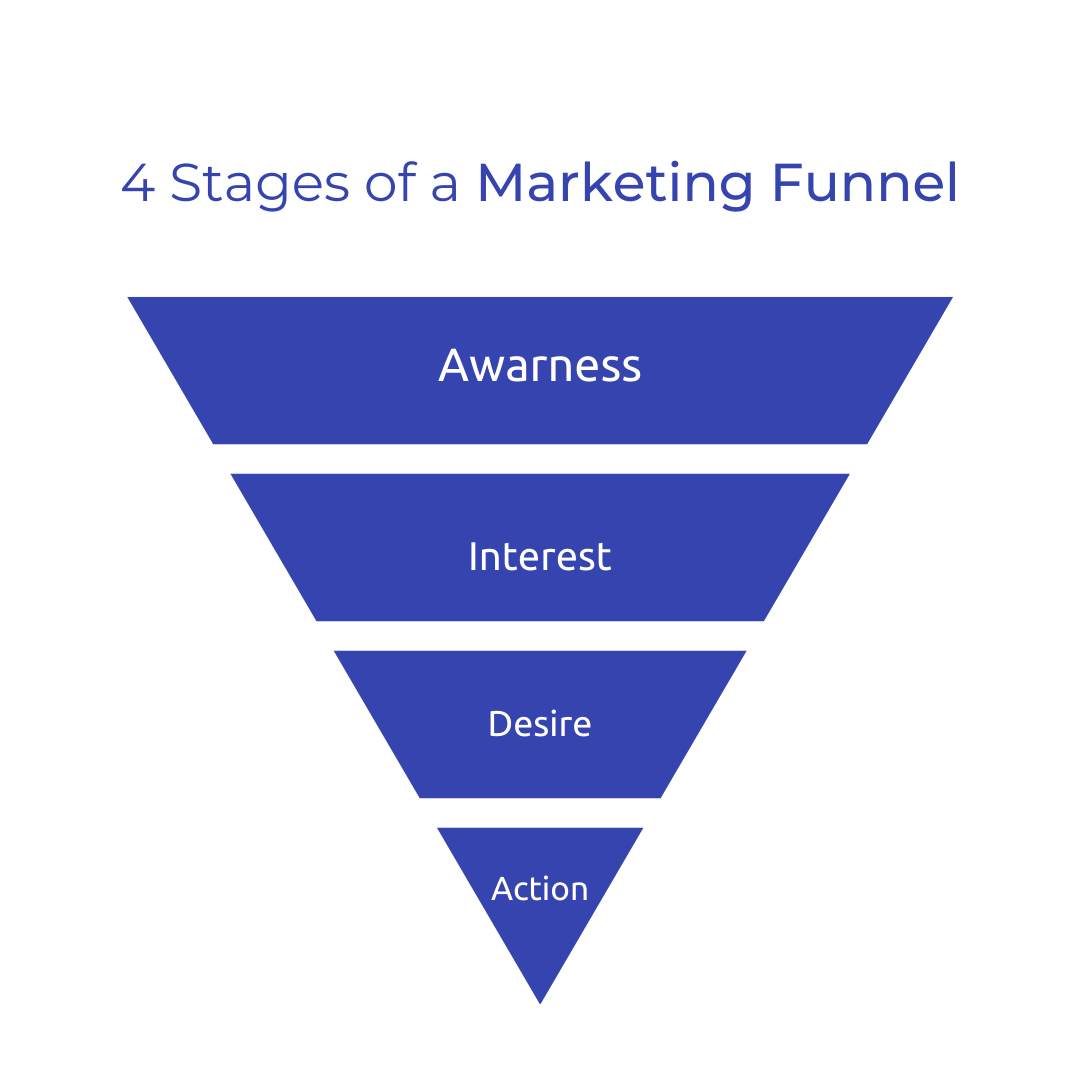Buildin a marketing funnel is the backbone of any successful digital marketing campaign. But it’s not just about driving traffic to your website — it’s about guiding potential customers on a journey from awareness to conversion.
Simply put, a marketing funnel is a way of breaking down the customer journey from when they first find out about your brand to converting into customers. A marketing funnel can also give you useful insights into why some customers convert — and others don’t.
Let’s look at the intricacies of how to build a marketing funnel, exploring each stage and providing you with invaluable tips and strategies to make sure your funnel not only captures attention, but also converts prospects into loyal customers.
What Is a Funnel in Digital Marketing?
A funnel in digital marketing is a strategically designed pathway that leads potential customers from initial contact to conversion. It’s a framework that helps businesses systematically nurture and guide their audience towards taking desired actions, whether that’s making a purchase, signing up for a newsletter, or becoming a loyal advocate for your brand.
A marketing funnel, as its name implies, can be likened to an inverted funnel shape, and it comprises two fundamental components — the “top of the funnel” (TOFU) and the “conversion path”.
Top of the Funnel (TOFU)
This is the wide-mouthed entry point of the funnel, where you cast a wide net to capture leads from prospective customers who are just discovering your brand. At this stage, these individuals might have stumbled upon your website through search engines or been enticed by your social media advertising.
To entice them further, you typically present offers that resonate with their initial awareness. For instance, you might offer a free trial, an informative e-book, or an engaging webinar to pique their interest. The key here is to offer something of value that encourages them to take the first step by providing their contact information.
Conversion Path
Once you’ve reeled in potential customers at the top of the funnel, your next mission is to guide them through a series of 4 stages, each requiring a greater level of commitment from the customer.
This path is aptly named the “conversion path” because your ultimate goal is to transform these prospects into paying customers or repeat buyers.
The 4 Stages of a Marketing Funnel
The 4 stages of a marketing funnel are represented by the acronym AIDA — Awareness, Interest, Desire, and Action. These stages outline the journey potential customers take, from first encounter to conversion.
This marketing funnel framework works well in business-to-consumer (B2C) interactions and has some differences from a B2B marketing funnel.
Let’s examine each stage with real-life examples of how businesses strategically guide their audience through the funnel.

1. Awareness Stage (A):
The Awareness stage is the initial point of contact, where potential customers first discover your brand, product, or service. It’s about capturing their attention and making them aware of your existence.
For example, the global beverage giant, Coca-Cola maintain awareness by using captivating TV ads, billboards, and social media campaigns. The iconic red cans and polar bear mascots are forever ingrained into the consumer’s consciousness.
2. Interest Stage (I):
In the Interest stage, potential customers have already shown curiosity in your offerings. They want to learn more, so it’s your job to provide them with enticing details and build their interest further.
Amazon has perfected this stage. When you visit their website, you’ll notice personalised product recommendations, detailed product descriptions, and customer reviews — all designed to pique your interest and help you make an informed decision.
3. Desire Stage (D):
As potential customers progress to the Desire stage, they’re likely to have already decided that hey want what you’re offering. Now, you must stoke their desire further and show them why your product or service is the best choice.
Apple excels at stoking consumer desire. Their product launches create an aura of anticipation and desire. They highlight sleek design, cutting-edge features, and user-friendly interfaces, making consumers crave the latest iPhone or MacBook.
4. Action Stage (A):
The Action stage is the final stage where potential customers are ready to convert. They’re on the verge of making a purchase, signing up, or taking a specific action you desire.
Online travel agencies like Booking.com skilfully guide potential travellers to the Action stage. They showcase enticing hotel deals, limited-time offers, and clear booking processes, making it effortless for users to take the final step and secure their accommodations.
What Is a B2B Marketing Funnel?
A B2B marketing funnel takes a distinctive approach, reflecting the complex nature of business-to-business transactions. It embodies a strategic journey, carefully tailored to cater to the unique needs, challenges, and decision-making processes of fellow businesses.
The main focus is on nurturing long-lasting business relationships, setting it apart from the more straightforward AIDA framework commonly used in B2C marketing. This is highly important because almost 80% of marketing leads never convert into sales due to a lack of lead nurturing.
The key stages of a B2B marketing funnel are:
Awareness
At the outset, the B2B marketing funnel centres on creating awareness among businesses regarding the products or services being offered. This often involves a blend of targeted marketing strategies, such as content marketing, participation in industry-specific events, and precise online advertising. The objective here is to capture the attention of potential B2B clients.
Interest
Having established awareness, B2B marketers should shift their focus to cultivating interest and trust. In this stage, it’s important to provide comprehensive information, case studies, and live demonstrations to exhibit the value and benefits of your offerings.
Webinars, whitepapers, and personalised consultations are integral tools for engaging and educating potential B2B clients.
Consideration
In the consideration stage, businesses typically evaluate their options and thoroughly consider the different B2B solutions available to them. B2B marketers must emphasise unique selling propositions (USP’s) and demonstrate how their product or service can effectively address specific pain points and deliver superior results.
This often requires detailed proposals, tailored presentations, and a deep understanding of the client’s specific needs.
Decision
At the bottom of the funnel, businesses are typically ready to make a decision. It’s important for B2B marketers to provide clear and compelling calls to action, streamline the purchasing or contract negotiation process, and offer exceptional customer support to encourage businesses to choose their product or service.
Contract negotiations, legal considerations, and negotiations on terms and pricing may be more prevalent in this stage compared to B2C transactions.
Retention and Advocacy
Beyond the conversion, a successful B2B marketing funnel should place significant emphasis on post-purchase activities. Building strong and lasting customer relationships, providing ongoing support, and fostering an environment where satisfied clients become advocates and refer other businesses are essential for long-term success.
What Is The Difference Between B2B and B2C Funnel?
B2B and B2C marketing funnels serve different audiences and involve distinct strategies and approaches. While both aim for conversion, they adapt their messaging, content, and engagement tactics to cater to the unique characteristics of either business or individual consumers, reflecting the diversity of the marketing landscape.
Let’s explore the key differences between these two funnels to understand how they diverge in execution and purpose.
1. Target Audience
The B2B marketing funnel targets businesses as customers or clients. It navigates the complexity of corporate decision-making, often involving multiple stakeholders, departments, and a focus on long-term partnerships.
In contrast, the B2C marketing funnel focuses on individual consumers as the primary audience. It addresses the needs, preferences, and emotions of individual customers, aiming for more immediate and often transactional interactions.
2. Complexity of Decision-Making
B2B transactions typically involve complex decision-making processes. Businesses may require in-depth research, proposal evaluations, negotiations, and considerations of long-term contracts, making the funnel stages more intricate.
On the other hand, B2C transactions tend to be less complex with individual consumers often making quicker purchase decisions based on personal preferences, emotions, and immediate needs.
3. Communication and Engagement
B2B marketing relies on professional and technical language, targeting decision-makers who seek detailed information and a clear understanding of how a product or service addresses specific business challenges.
B2C marketing employs a more emotionally resonant approach, utilising relatable storytelling, user-generated content, and social proof to engage consumers on a personal level.
4. Content and Messaging
Content in the B2B funnel emphasises industry expertise, case studies, and data-driven insights. Messaging focuses on addressing business pain points and ROI (Return on Investment).
B2C content is often more visual, entertaining, and user-friendly. Messaging centres around product benefits, emotional connections, and lifestyle alignment.
5. Sales Cycle Duration
B2B sales cycles tend to be longer, often spanning several weeks or months due to the need for extensive evaluations, negotiations, and consensus-building among decision-makers.
B2C sales cycles are generally shorter, as individual consumers make relatively swift purchasing decisions based on personal preferences and immediate needs.
6. Post-Purchase Engagement
Post-conversion efforts in B2B marketing focus on long-term relationship building, ongoing support, and encouraging client businesses to become advocates or repeat buyers.
B2C post-purchase engagement centres on customer retention, addressing inquiries, and encouraging individual customers to become brand advocates through referrals and social sharing.
What Is The Difference Between a Conversion Funnel and a Marketing Funnel?
The difference between a conversion funnel and a marketing funnel is their objectives and approaches.
The primary aim of a conversion funnel is prompting a specific, often immediate, action. This action can include making a purchase, signing up for a newsletter, or any other predefined step that marks a pivotal point in the customer’s journey. A conversion funnel is linear in nature, focusing on a singular objective: conversion.
This type of funnel is highly quantitative, allowing marketers to track and optimise each stage’s performance. Metrics such as click-through rates (CTRs), conversion rates, and cost per acquisition (CPA) are very important for evaluating the funnel’s efficiency, with the emphasis being on enhancing conversion rates and minimising drop-offs throughout the customer journey.
On the other hand, a marketing funnel takes a more holistic approach to the customer journey. It does not focus solely on achieving a single conversion but aims to nurture lasting relationships and build brand loyalty. A marketing funnel encompasses a wider spectrum of customer interactions and touchpoints, recognising that customer journeys are rarely linear. Prospects can enter the funnel at various points and engage with multiple touchpoints several times before making a conversion decision.
But these two funnel types are not mutually exclusive and can often complement each other. For example, the marketing funnel can feed customers into the conversion funnel. A well-structured marketing strategy will enhance your brand awareness and customer loyalty, making the subsequent conversion process more efficient and effective.
What Is The Difference Between a Marketing and Sales Funnel?
The key difference between a marketing and sales funnel lies in their objectives and timing.
The marketing funnel is about creating awareness, fostering relationships, and generating leads, while the sales funnel is all about converting those leads into actual sales. It is a more focused and transactional funnel, aimed at converting leads into paying customers.
These funnels often work in tandem, with the marketing funnel feeding qualified leads into the sales funnel. It’s important to understand the synergy between these two funnels and use them strategically to maximise your customer acquisition and revenue generation efforts.
How To Build a Marketing Funnel in 5-Steps
Marketing funnels are all about trying to turn potential customers into buying customers — or better yet, repeat customers who come back again and again.
Building a marketing funnel requires a careful consideration of who your target audience is. For B2C audiences, adhering to the well-established AIDA framework can be highly effective. However, for B2B customers, a tailored approach is often necessary to address the unique complexities of corporate decision-making.
Here is a simple 5-step guide on how to build a marketing funnel that will maximise your conversion rates.
Step 1: Grab Your Audience’s Attention
The first step in building a marketing funnel is to capture your audience’s attention. This involves creating compelling and eye-catching content that piques their interest.
Use attention-grabbing headlines, visually appealing graphics, and engaging social media posts to draw potential customers in. Make sure your content addresses a problem or need that resonates with your target audience.
Step 2: Generate Interest in Your Offers
Once you have your audience’s attention, your next task is to generate interest in what you have to offer. Develop content that provides value and information relevant to your audience’s needs. This can include blog posts, informative videos, or educational webinars.
The goal here is to keep your audience engaged and eager to learn more about your products or services.
Step 3: Create a Strong Desire for Your Products or Services
Building desire in your audience involves showcasing how your products or services can solve their problems or fulfil their desires. This is where you highlight the unique selling points, benefits, and advantages of what you’re offering.
Customer testimonials, case studies, and product demonstrations can be particularly effective at this stage. Make your audience truly desire what you’re selling.
Step 4: Prompt Immediate Action
The ultimate goal of your marketing funnel is to guide your audience toward taking a specific action. This action could be making a purchase, signing up for a newsletter, or requesting a free trial.
Create a sense of urgency or an enticing call-to-action that encourages immediate steps. Ensure that your landing pages and checkout processes are user-friendly and optimised for conversion.
Step 5: Maintain and Enhance Customer Relationships
The funnel doesn’t end with the purchase or action. To build lasting relationships, implement a post-action strategy.
This involves post-purchase follow-up, customer support, and nurturing customer loyalty. Continue to provide valuable content and personalised offers to keep your customers engaged and eager to return.
5 Marketing Funnel Tactics Examples
By aligning your marketing strategy with each stage of your funnel, you can guide potential customers through a structured journey that leads to conversions and long-term brand loyalty.
Here are 5 additional marketing funnel tactics you can use to help you do that.
1. Make Your Product or Service Great
The foundation of any successful marketing funnel begins with the quality of your product or service. Before enticing potential customers, make sure that what you offer is not just good but great.
When your customers find immense value in what you provide, they have little reason to seek alternatives.
2. Streamline Payment Processes
Convenience is paramount in the customer journey. Make sure that the path to making payments is as frictionless as possible. Incorporate diverse payment methods, such as PayPal and other trusted options, at the checkout stage.
This flexibility ensures that customers can complete transactions with ease, reducing the likelihood of cart abandonment.
3. Craft Compelling Offers at Each Stage
A successful marketing funnel is a progression of enticing offers that guide customers from awareness to action. Tailor your offerings to align with each stage of the funnel.
For example, at the awareness stage, consider providing valuable content, like eBooks or informative blog posts, to capture initial interest. As they move deeper into the funnel, introduce exclusive deals, trials, or bundled packages to sustain their journey.
4. Leverage Email Marketing
One potent tool for nurturing potential customers through your funnel is email marketing. Encourage visitors to sign up for your email newsletter, as this provides a direct line of communication. Once subscribed, you can send them regular updates, personalised recommendations, and exclusive offers without requiring them to actively search for information.
This ongoing engagement keeps your brand top-of-mind.
5. Tailor Funnels to Specific Products or Services
Depending on your product or service offerings, you can create individual marketing funnels tailored to each one’s unique characteristics and target audience.
Alternatively, you can build a comprehensive funnel that encompasses all your offerings. The choice depends on the nature of your business and the diversity of your products or services.
In Conclusion
Whether you’re engaging individual consumers through B2C strategies or navigating the complex world of B2B interactions, understanding how to build a marketing funnel is essential. For B2C audiences, the AIDA framework serves as a reliable guide, while B2B customers demand a tailored approach to address their unique needs.
To build marketing funnels that truly convert, remember to prioritise product or service excellence, streamline payment processes, and craft compelling offers at each stage. Leverage the power of email marketing to maintain engagement, and consider whether individual funnels or a comprehensive approach best suits your business.








